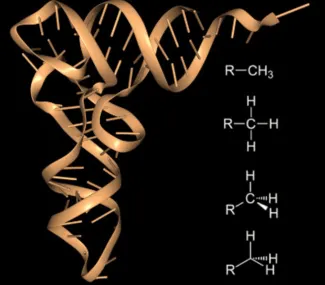Exploring RNA | Overview
RNA comes out from the shadows
By the time the COVID-19 vaccine thrust RNA into the limelight, scientists were well aware of its potential. Sometimes chemicals such as methyl get added to RNA's surface, giving it the power to boost protein production. But if too much is added, our health can suffer.
Two of our investigators are studying these modified RNAs to help understand diseases and to guide treatment development.
Richard Gregory, PhD, is building on his discovery that, when RNA acquires more methyl compounds than needed, cell divisions explode, triggering cancer. Conversely, too little methyl interferes with childhood development, leading to neurological disorders, such as dwarfism and microcephaly (small brain).
Ryan Flynn, MD, PhD, discovered that RNA, once thought to exist solely inside cells, can bind with sugar molecules, making a home on the cell surface. Whether this location affords RNA with novel therapeutic powers or ramps up disease vulnerability—or both—will be a focus of his research.
RNA and cancer
In an important discovery, Dr. Gregory found that cancer can result when a small piece of genetic code is disrupted in non-coding RNA. He then found that other alterations to RNA could fuel cancer as well. "We now appreciate that, like DNA, RNA—the intermediate between the gene and the protein—can be "modified" [by chemical additions]," says Dr. Gregory. These changes are mostly helpful but can also wreak havoc.

For example, the enzyme METTL3 adds methyl to messenger RNA to fine-tune gene expression. But, as he was the first to realize, METTL3 is dysregulated in cancer—and too much of it can trigger cancers such as acute myeloid leukemia. Since then, the team identified a second enzyme, METTL1, that latches onto transfer RNA—tRNA—the type of RNA used in the final step of translating a gene into a protein. As with METTL3, large amounts can spark cancers—in this case, liposarcoma or glioblastoma.
New drug targets for cancer
Cancer cells need METTL1 and METTL3 much more than healthy cells do. "If we knock out METTL3 in blood stem cells, they survive just fine. But if you knock it out in acute myeloid leukemia cells, they die," says Dr. Gregory.
Drugs that can silence METTL3 or METTL1 may be able to take these cancers down. That’s why the team is testing several candidates in test tubes. And they aren’t stopping there.
"Knowing the chemical structures of METTL1 and METTL3 allowed us to design computational models to look at millions of compounds, searching for one that can spark the desired chemical reaction," says Dr. Gregory. Next, they hope to test promising candidates in cancer cell lines and preclinical models. "Our goal is to partner with clinicians and move promising candidates toward the clinic over the next several years," he says.
Meet our new RNA expert
Dr. Ryan Flynn discusses his research in a short video
Viewing RNA from a new vantage point
Now that we know RNAs can thrive on the cell surface, a new frontier of possibilities is unfolding. What can RNA do from its perch on the top of the cell that it cannot do from inside it and how can its position there be used to our advantage?
Dr. Flynn points out that RNA is a flexible platform. It can bind to molecules, shut down or enhance cell-to-cell communication, or help cells hide from the immune system. Because it is so versatile, Dr. Flynn thinks we should be able to tweak it in ways that can help us combat disease.

We now have three ‘hands’ on the cell surface. From left to right, a glycoprotein, a glycolipid, and the newly discovered glycoRNA. (Illustration: Ryan Flynn/Sebastian Stankiewicz, Boston Children’s Hospital)
"For example, blood cancers may have too much sugar RNA [glycoRNA] on the cell surface and that could cause cancer. We could develop a therapy to cut the RNA off the cell surface, reducing cancer growth," he says.
In short, by developing glycoRNA-based therapies, we may be able to address a myriad of diseases by enhancing or blocking cell-surface glycoRNAs on diseased cells.
RNA and autoimmune disease: A topic for the future
Our cell surfaces are covered in lipids, sugars and proteins that help transmit signals back and forth. But sometimes unwanted visitors invade, triggering immune cells to swoop in and attack. In autoimmune diseases, such as lupus, RNAs can be mislabeled as "imposters” and assaulted.
Until Dr. Flynn discovered that RNA can reside both inside and outside of cells, it was unclear how the immune system —which does not patrol the cell's interior— could find the RNA to kill it.
"Knowing that RNA has access to the cell surface changes the way we think about autoimmune diseases and gives us new ideas about how to treat them," says Dr. Flynn.
While many questions remain regarding the roots of autoimmune disease, we are certain Dr. Flynn's investigations will bring some resolution in the coming years.

